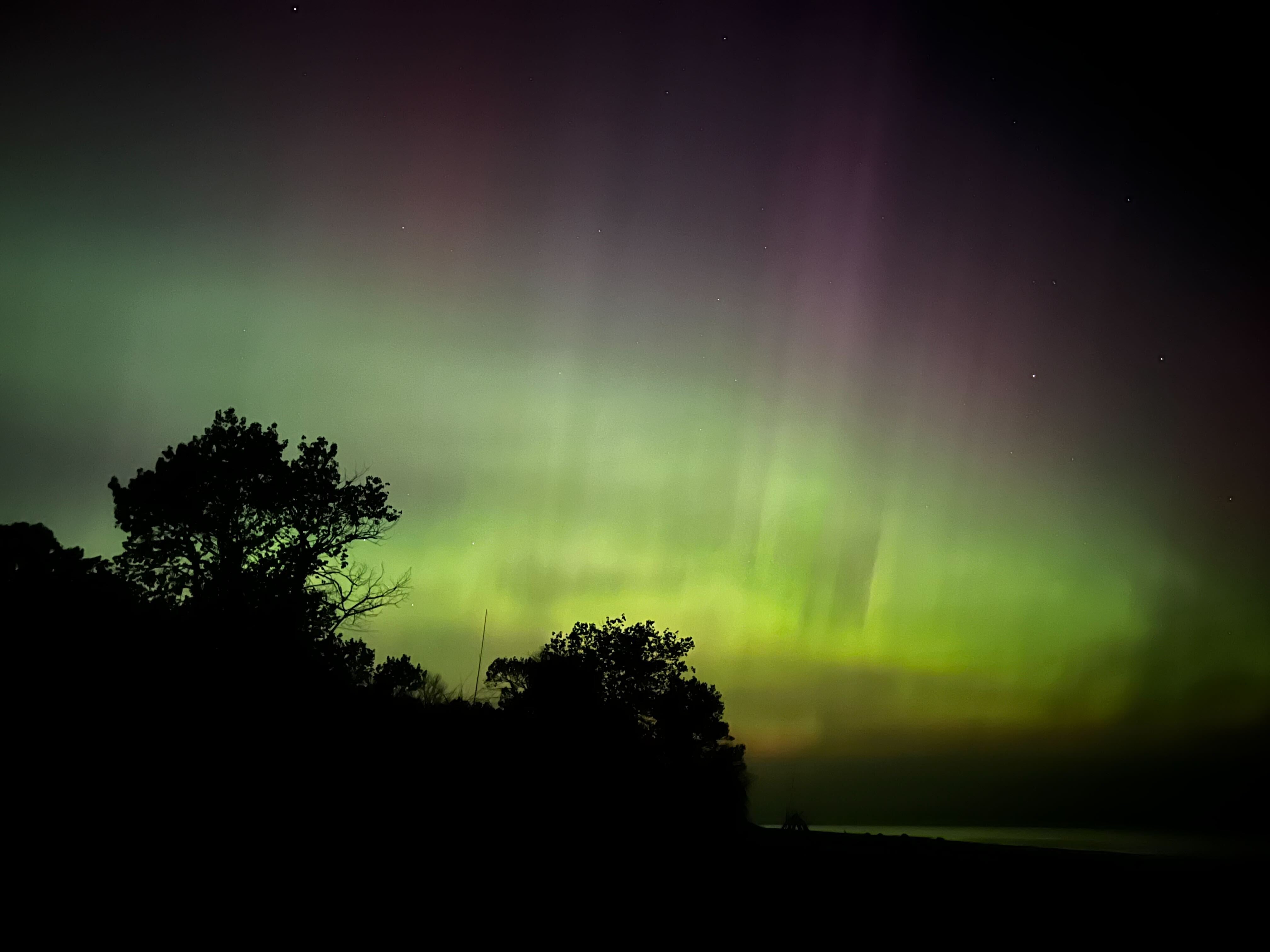
Hunting for aurorae is one of the most accessible forms of visual astronomy. To see the northern lights, all you have to do is find a good dark-sky site, a clear horizon, and look north — in the Northern Hemisphere, of course. (In the Southern Hemisphere, a G4-level storm could generate aurorae visible at dark-sky sites as far north as Sydney and Perth.) The best time to observe the northern lights is around midnight, when the auroral oval is typically farthest south and the sky is darkest.
Keep in mind that if your dark-adapted eyes can’t see anything, a camera — even the one on your phone, in night mode — may well be able to capture aurorae that you cannot. And if you snag a good shot, send it to us at readergallery@astronomy.com!
Editor’s note— The storm began Friday. Here are the latest updates and photos:
Friday May 10, 23:40 p.m. EDT: At 6:54 p.m. EDT today, G5 conditions were observed at Earth, reports SWPC. As the night has unfolded, it has become clear that this is one of the most powerful solar storms in decades, setting skies above Europe ablaze and yielding reports of aurorae as far south as the Hanle Dark Sky Reserve, in India, and as far north (in the Southern Hemisphere) as Namibia.
As the Sun set on North America, sightings in the Bahamas and Florida abounded. Travelers lucky enough to be in the air facing the auroral oval were treated to a spectacular show, including Astronomy contributor Yvette Cendes.
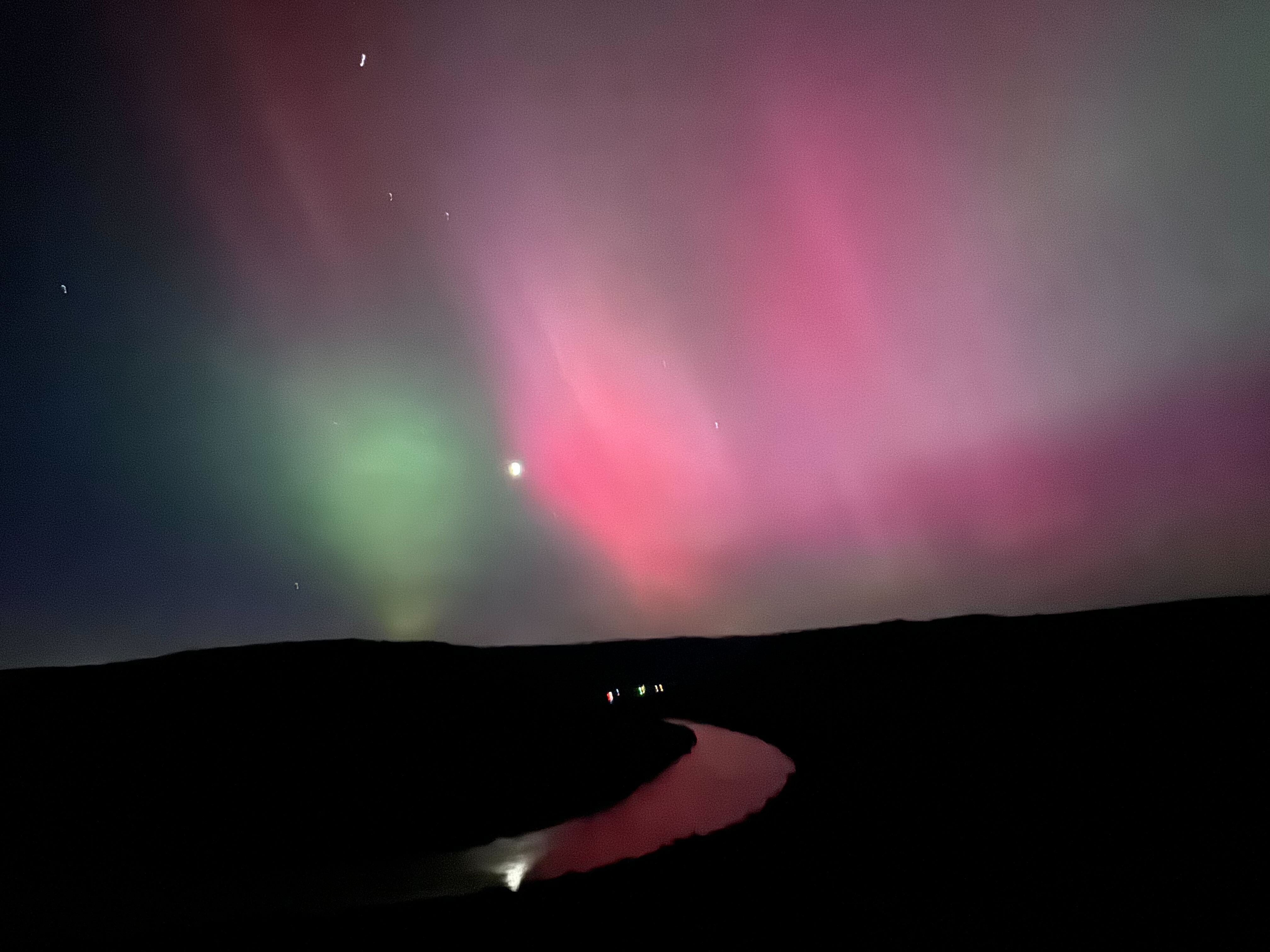
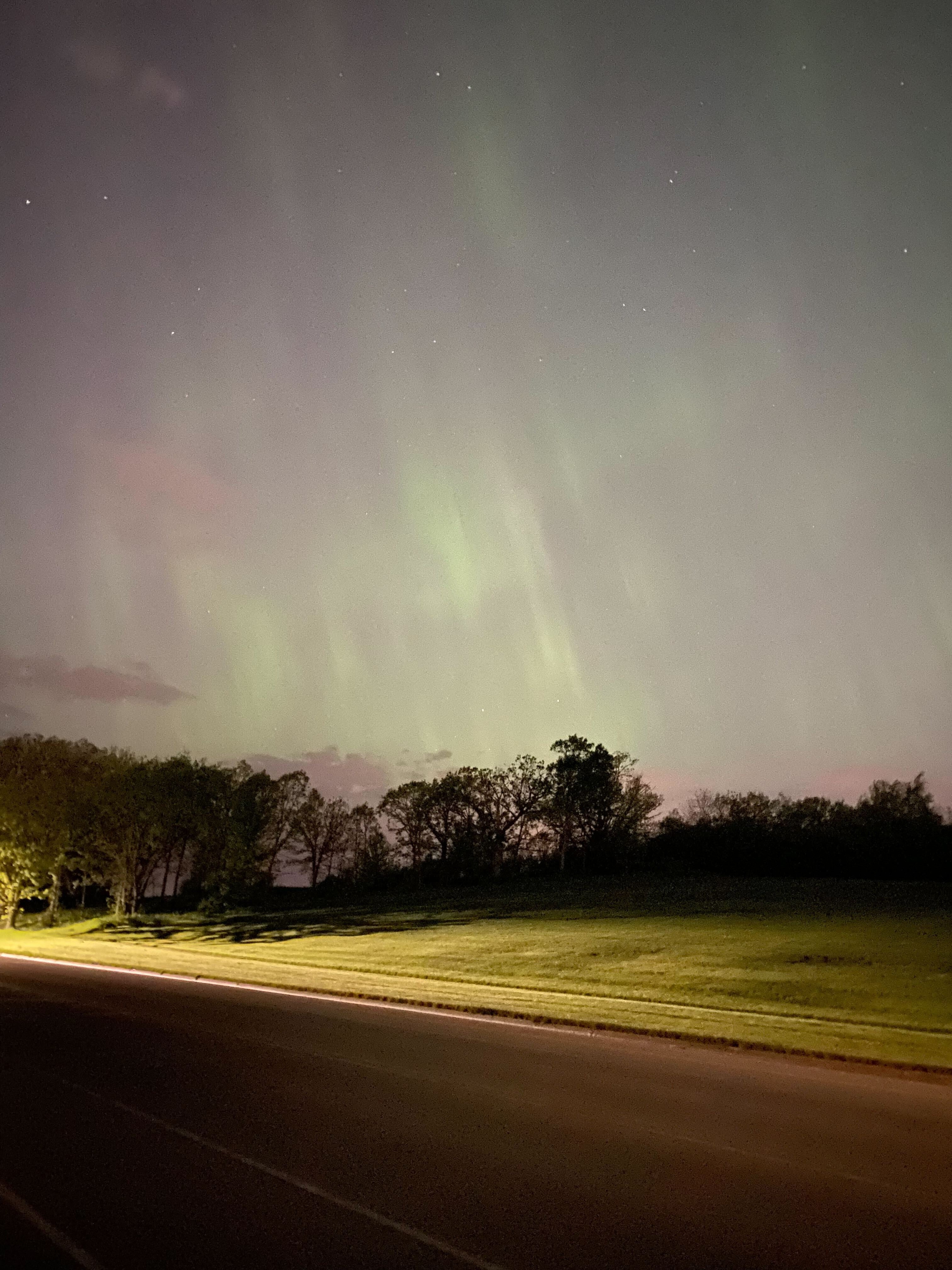
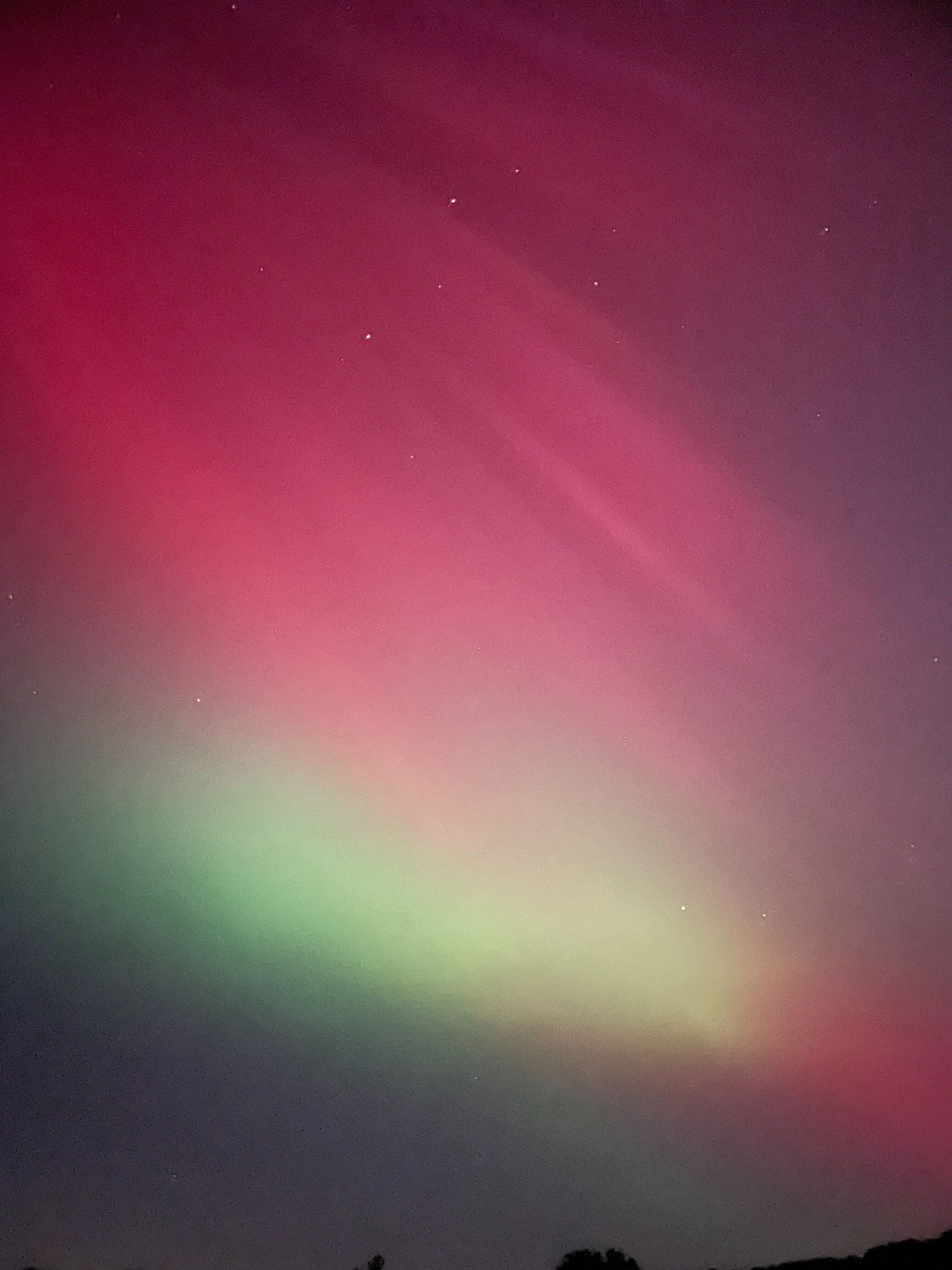
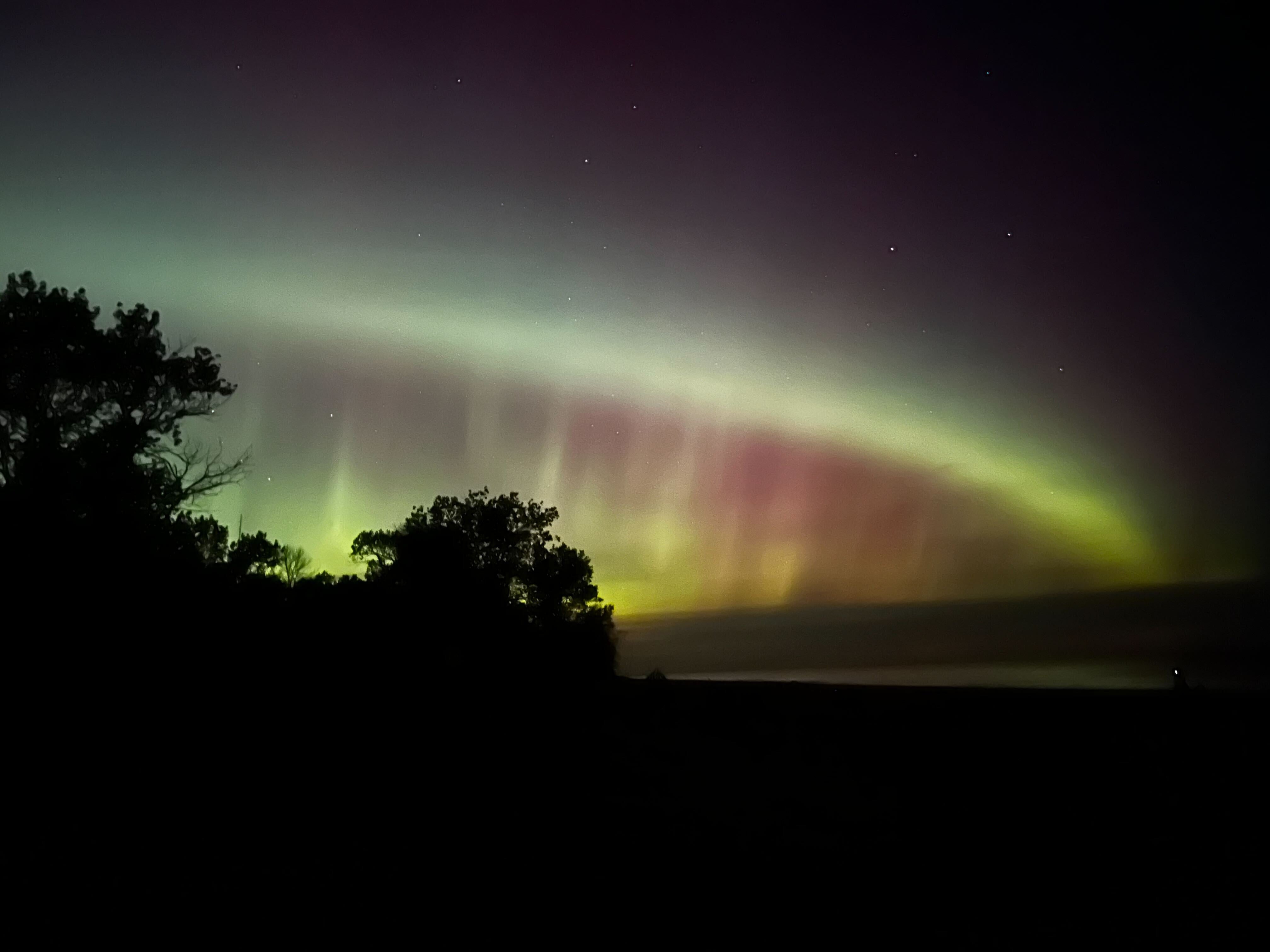
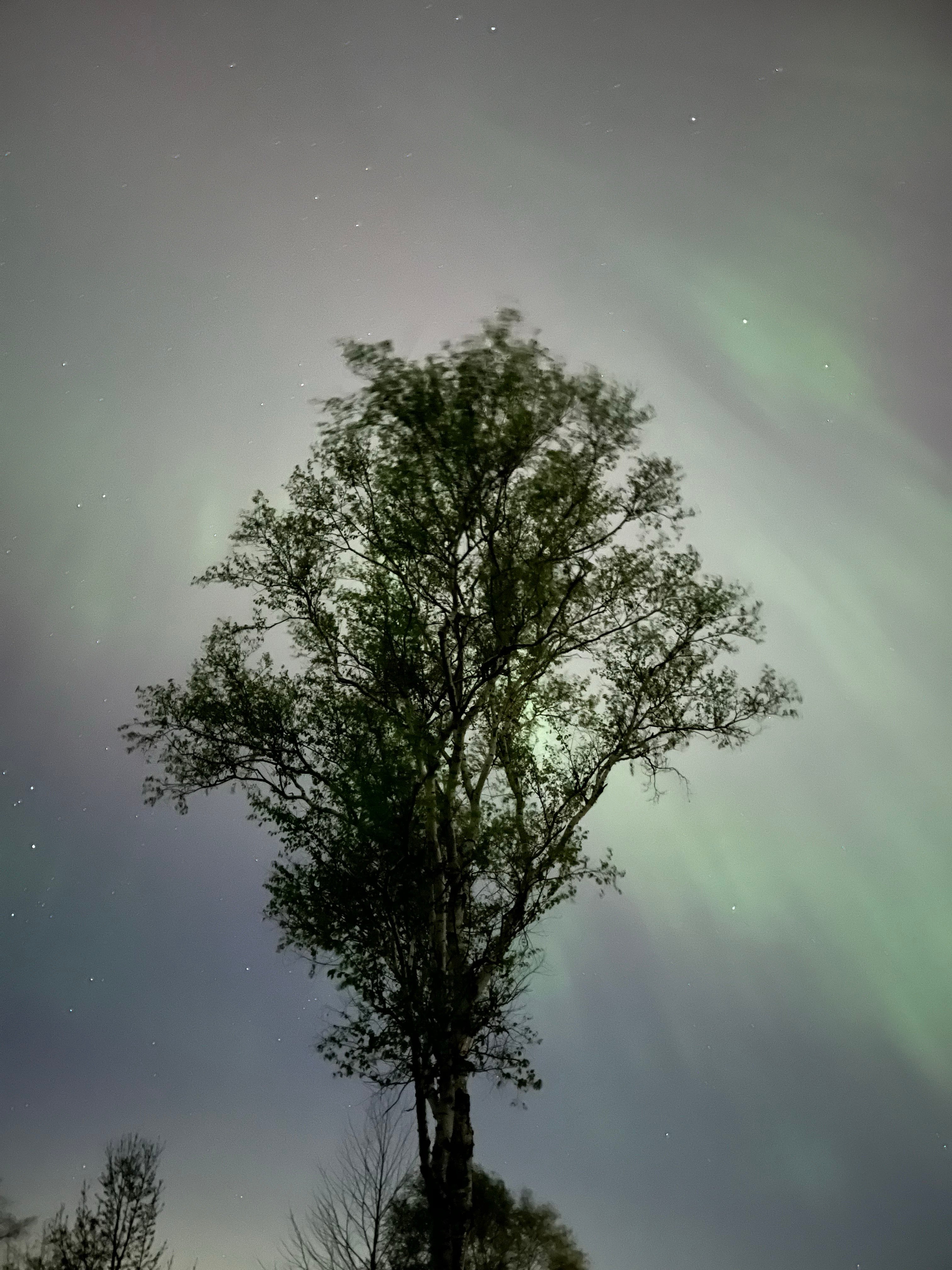
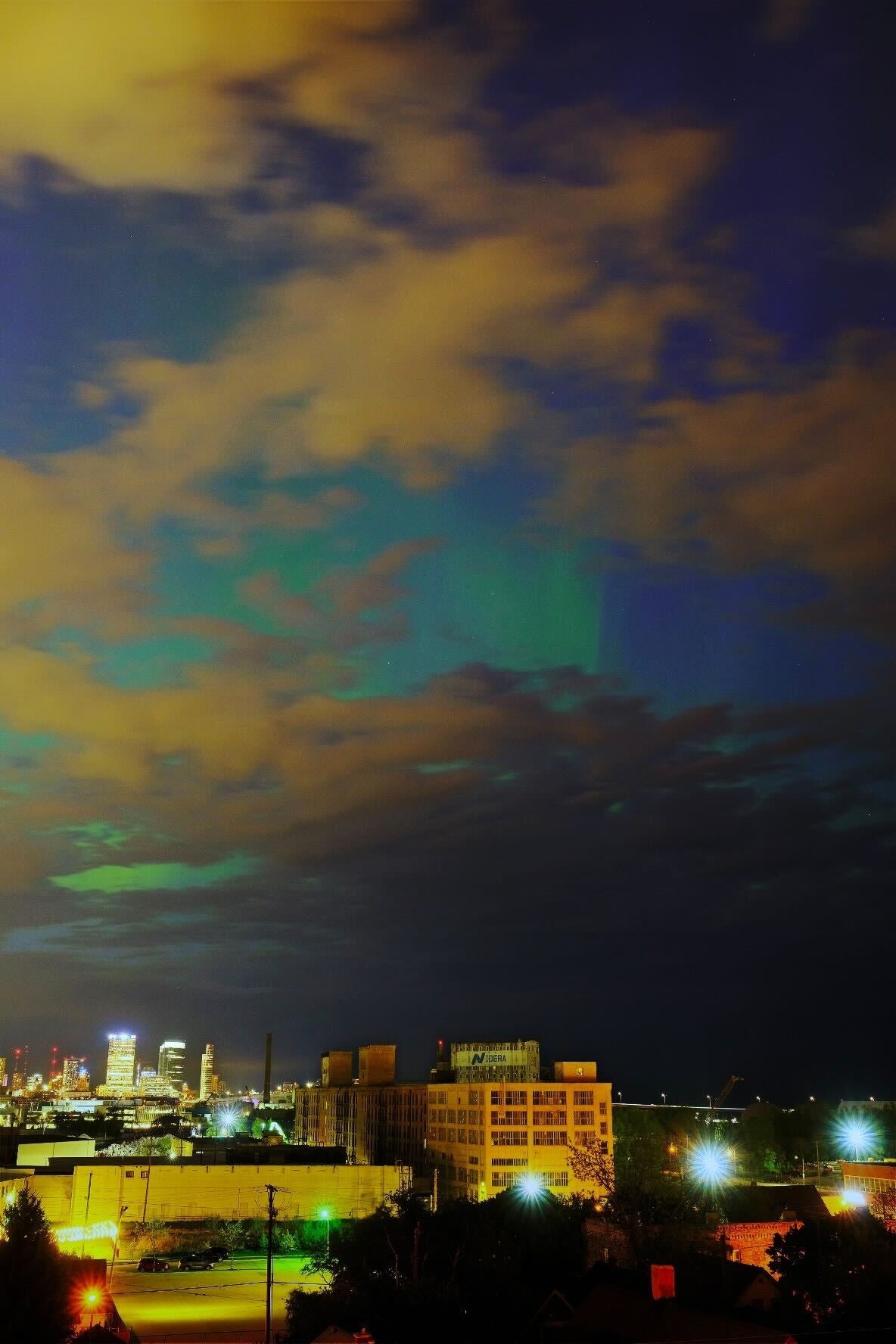
Friday May 10, 1:48 p.m. EDT: The storm has started. At 1:14 p.m. EDT, SWPC issued a G1-level warning, based on readings of the storm from satellites placed in between Earth and the Sun, at the L1 point. That quickly became a G2- and then a G3-level warning, equivalent to a Kp-index value of 7. (The Kp-index is another measure of the level of geomagnetic activity.) At this point, Dahl said earlier today, SWPC stops sending out warnings to infrastructure operators. “The reason we do that is because things can escalate so quickly that it gets out of control on how many people were contacting and notifying, but the alerts continue to go out.”
Friday May 10, 2:01 p.m. EDT: At 1:44 p.m. EDT, SWPC issued a G4-level warning. Also of note, another index of storm activity that measures levels of dangerous solar radiation, the S scale, has risen from 1 to 2, which space agencies will surely continue to monitor. On rare occasions, astronauts have been required to shelter in areas of their space station that provide more protection against an oncoming storm. There are currently 7 astronauts aboard the International Space Station and three on the Chinese Tiangong space station.
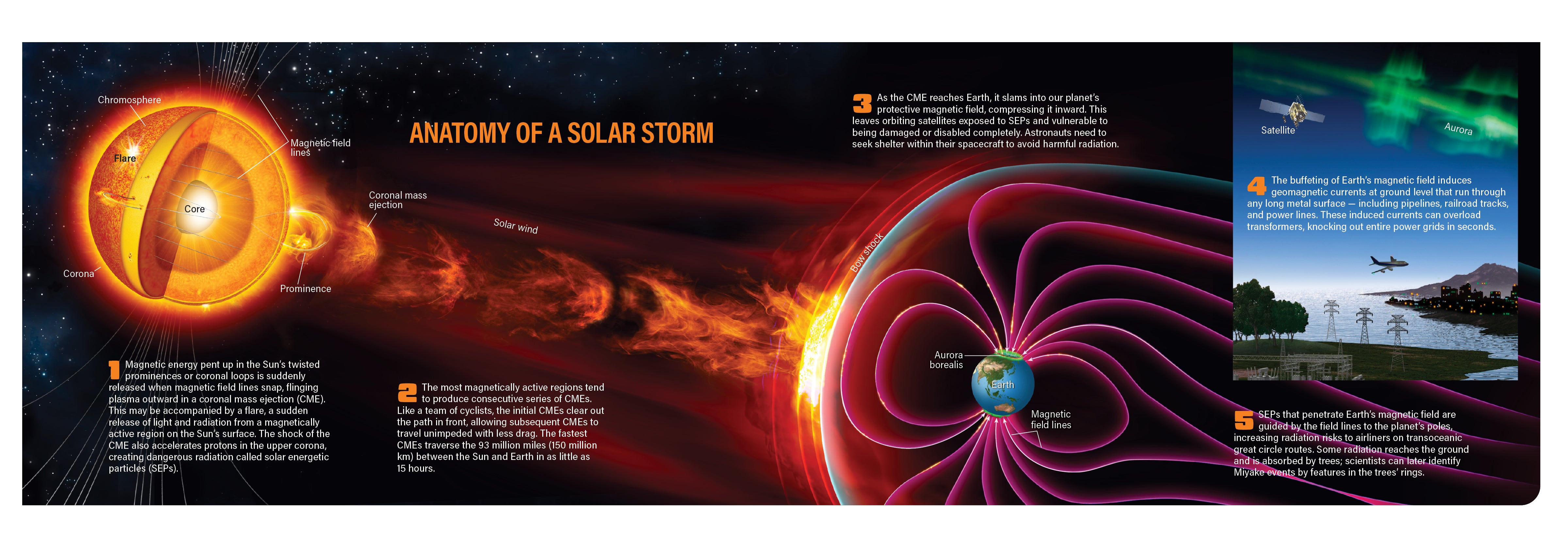
You can see a real-time gallery of northern lights photos here on spaceweather.com.
The storm that’s bringing the northern lights
The most powerful solar storm to be forecast in nearly two decades is about to arrive at Earth late May 10, and could trigger auroral displays across much of the continental U.S. tonight and through this weekend.
This gathering cloud of plasma ejected from the Sun prompted U.S. government forecasters on May 9 to issue a severe geomagnetic storm watch — the first such watch in nearly 20 years. Formally, that’s a G4-level watch, which ranks as the second highest level, behind a G-5. The watch is in effect for today (May 10) and through the weekend. And while power companies take measures to protect their grids and GPS users prepare for potential disruptions, solar astronomers and aurora watchers are rubbing their hands together in glee, because the Sun’s 11-year-long activity cycle just kicked into high gear.
A solar storm watch
The last time that the Space Weather Prediction Center (SWPC) at the National Oceanic and Atmospheric Administration (NOAA) issued a G4-level watch was January 2005.
While space weather forecasting is subject to much uncertainty, the general definition of a G4-level storm includes aurorae visible potentially as far south as northern California and Alabama. (At maximum extent, the auroral oval tends to extend deeper into the Midwest toward the Gulf of Mexico than in other parts of the U.S.)
Of course, just like a tornado watch, a geomagnetic storm watch doesn’t mean that a storm of that strength is guaranteed to materialize. (Compare that to a tornado warning, which means a tornado has actually been detected.)
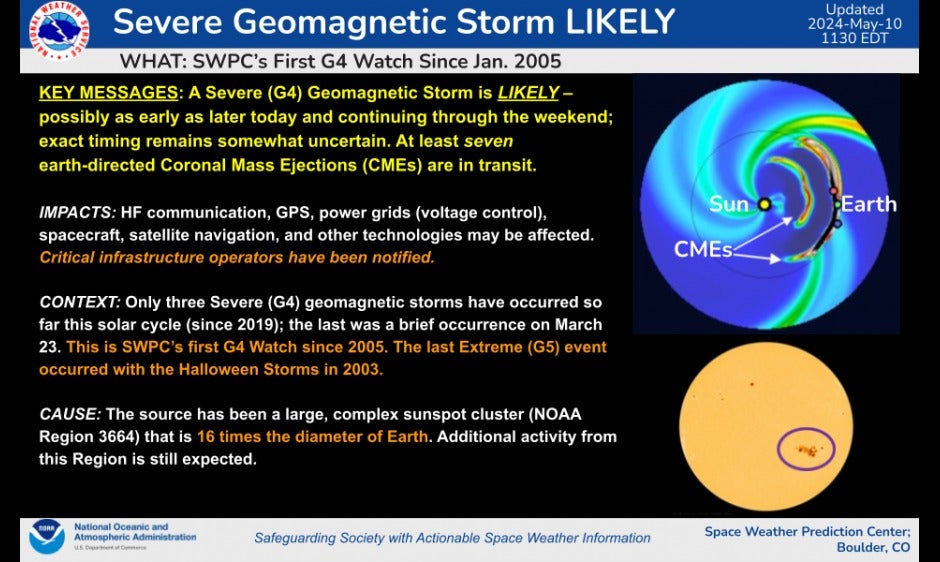
Space weather forecasters won’t be able to directly measure the approaching storm until it reaches satellites that are stationed at the L1 point between Earth and the Sun, roughly 1 million miles away. At that point, SWPC will begin issue geomagnetic storm warnings, if they are warranted. The storm is currently barrelling toward us at around 500 miles per second (800 km/s), said Shawn Dahl, a SWPC space weather forecaster, in a teleconference with media May 10. That means a storm warning will give satellite operators and power companies roughly 20 to 45 minutes of lead time before the storm begins to pound into our planet’s magnetic field.
A perfect storm
This storm is a result of an intense sequence over the past few days in which the Sun has spat out half a dozen clouds of plasma — or coronal mass ejections (CMEs) — all originating from a massive sunspot group known as AR3664 that has grown to around 125,000 miles (200,000 kilometers) across, or 16 times the diameter of the Earth. It is “one of the largest and more complex ones that we’ve seen in the solar cycle — perhaps the most complex one this solar cycle,” said Dahl.
These storms were all ejected at different speeds, meaning some of them are running into each other and merging into a larger, more powerful storm. “We have a very rare event on our hand,” said Dahl.
SWPC forecasters say current models predict the storm will arrive around 8 P.M. EDT, but they caution that there is quite a bit of uncertainty in that forecast and it could arrive a few hours before or after.
Even if timing and weather isn’t ideal for aurora watchers tonight, the storm could well continue through the weekend. “This sunspot cluster has been sending off new, very large, coronal mass ejections about every 6 to 12 hours,” said Brent Gordon, head of SWPC’s space weather services branch. “And the latest one happened overnight, about 3 A.M. EDT. We anticipate that we’re going to get one shock after another in the weekend. So we’re really buckling down here to see what we get at this point.”
Battening down the hatches
When powerful geomagnetic storms pound Earth, they can cause the planet’s magnetic field to reverberate with waves that can wreak havoc on the ground, inducing electric currents in power lines that can take out entire grids. An exceptionally powerful storm in March 1989 famously knocked out nearly the entire power grid of the Canadian province of Quebec for nine hours.
While scientists don’t expect a G4-level event to have catastrophic impacts, “there could be some infrastructure effects,” said Dahl. “We’re a little concerned,” said Robert Steinberg, a SWPC space scientist. “We haven’t seen this in such a long time that we thought it warranted special attention.”
SWPC has notified operators of critical infrastructure like power grids and satellites of the impending storm “so they are able and prepared to take mitigation efforts as much as possible throughout this event, if it should unfold to the levels that we currently are anticipating,” said Dahl.
Individuals and industries that rely on GPS could be impacted by “potential signal lock loss or timing errors, making positional accuracy not spot-on,” said Dahl. Those effects could linger even after the bulk of the geomagnetic storm has passed.
Also at risk of disruption — and potentially even destruction — are any satellites that might happen to be in very low-Earth orbit. During a geomagnetic storm, the ionosphere (the charged particles in the Earth’s upper atmosphere) can expand outward, creating drag that can cause satellites to lose altitude and even suffer fiery deaths in accidental atmospheric reentries. In February 2022, SpaceX lost 38 just-launched Starlink satellites to an unexpected solar storm; when it hit, the individual craft hadn’t yet boosted themselves to a stable orbit.
SpaceX said it would learn from that setback, and that will be put to the test this weekend: On the night of May 9, at 9:30 P.M. PDT, SpaceX launched a flotilla of 20 more Starlink satellites from Vandenberg Space Force Base in California, less than 24 hours before the predicted onset of the geomagnetic storm.
The importance of Bz
Beyond the G scale and Kp index, another important number to look out for is Bz, as measured by the satellites stationed between us and the Sun that get a sneak preview of what is coming toward Earth. In short, a more negative Bz value tends to mean a stronger geomagnetic storm and more auroral activity. A value of -10 nanoteslas (nT) is considered a good indication of possible geomagnetic storm activity.
NASA’s STEREO-A spacecraft (positioned not at L1 but slightly ahead of Earth) is reporting a Bz value of something like –75 nT, as noted by space physicist Matthew Owens of the University of Reading, U.K., on X.
It has since bounced around, which is not surprising for a storm this complex. But the fact that it is predominantly negative goes some way towards explaining the strength of the storm we’re currently seeing.
B is the letter used in physics to represent the strength of a magnetic field, and z (written as a subscript) denotes that it is the z-axis (or vertical axis) component of the magnetic field. Thus, when a CME hits a spacecraft, the Bz value it reports is a measure of how strongly the magnetic field of the CME is pointed up (like Earth’s north pole) or down (like Earth’s south pole).
That’s important because Earth’s magnetic field is always pointing north (or, at least it has for the past 780,000 years or so). If the CME’s magnetic field is pointed south (a negative Bz value), they interact like two magnets whose opposite poles are attracting. It means the magnetic field of the CME can link up easily to Earth’s magnetic field, injecting it with energy. Like a particle accelerator, this gives electrons in Earth’s magnetic field a boost, pushing them down towards the poles. As they plunge into the atmosphere, they strike and energize oxygen and nitrogen molecules, and cause them to glow — creating the aurora.
If, on the other hand, the CME’s magnetic field is pointing north — the same as Earth’s — the CME and Earth’s magnetic field act like magnets repulsing. The interaction between them is weaker, and particles in Earth’s sphere of magnetic influence have a harder time finding the energy to push toward the poles.









